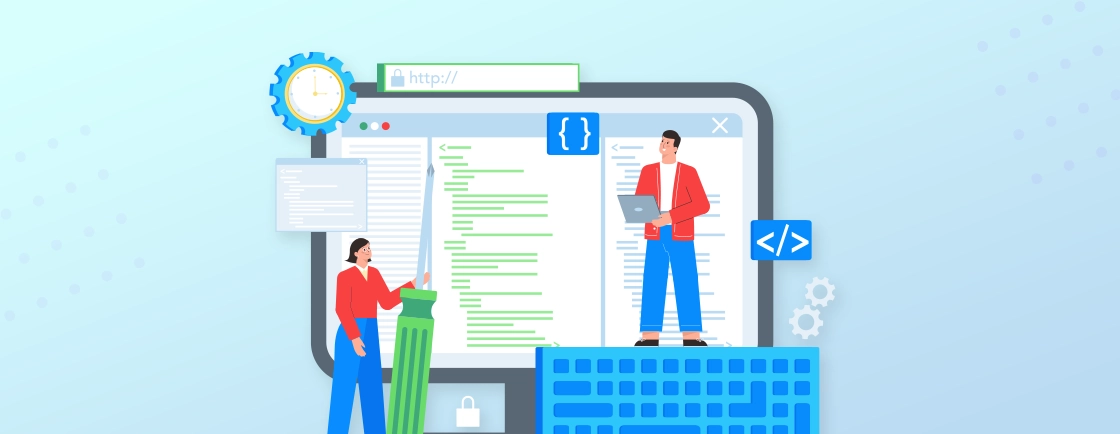Table of Contents
In the vast landscape of web development, programming languages serve as the building blocks that power the digital world. From crafting visually appealing front-end to implementing robust back-end functionalities, the selection of programming languages profoundly influences the success and efficiency of web projects.
This guide will serve you as a compass through these diverse rooms, spotlighting the top programming languages instrumental in web development. From the foundational structure laid by HTML5 and CSS3 to the dynamic interactivity brought by JavaScript, the server-side functionality enabled by PHP, Python and each language contributes its own unique strengths to the web development ecosystem.
Moreover, this exploration is not merely a rundown of languages but a comprehensive analysis of their use cases, advantages, limitations, and crucial factors to consider while choosing the right language for a project. Understanding these aspects will empower decision-making to navigate the complex web development landscape effectively.
Introduction to Programming Languages for Web Development
The web development process includes creating and maintaining web applications that rely heavily on a diverse collection of programming languages. These languages serve as the foundational tools empowering developers to craft everything from the layout and design of a website to its interactive functionalities and dynamic backend operations.
At the core of web development lie several key programming languages, each with its unique purpose and role. These languages collaborate to bring web projects to business norms, handling different aspects of the development process. There are several advantages this set of powerful programming languages offers:
1. Structuring Web Elements
Programming languages serve as the foundational tools for structuring web elements. They define the layout, text, images, and multimedia components, creating the visual and functional aspects of web pages.
2. Interactive User Experience
These languages enable the development of interactive features essential for user engagement. Capabilities such as form validation, animations, real-time updates, and responsive interfaces are made possible through these languages.
3. Back-End Functionality
Programming languages play a critical role in enabling server-side operations. They manage databases, process data, and handle user requests, forming the backbone of the application’s functional logic and data management.
4. Cross-Device Compatibility
Crucial for a seamless user experience, programming languages contribute to responsive design, ensuring compatibility across various devices and browsers. This adaptability enhances accessibility and usability.
5. Security Measures
The choice of programming language significantly influences the security of web applications. Different languages come with various security features and vulnerabilities, impacting the overall robustness of the application.
6. Performance Optimization
The performance of a website is significantly influenced by the choice of programming language. Load times vary based on language efficiency, impacting user experience and search engine rankings. Efficient resource management enhances application responsiveness, while a language’s scalability determines an application’s ability to expand seamlessly with increasing user demand.
7. Innovation and Adaptability
Programming languages are ever-evolving, providing new features, tools, and libraries. Developers can leverage these updates for innovation, adapting to the dynamic nature of web technologies and staying ahead in the competitive landscape.
The choice of programming language significantly influences a project’s success. Factors such as scalability, performance, security, community support, and learning curves all play vital roles in selecting the most suitable language for a particular web development endeavor.
Top 5 Programming Languages for Web Development
In the dynamic realm of web development, the choice of programming language significantly shapes the landscape, defining the core functionalities and user experiences of websites and web applications. The following section delves into the top seven programming languages essential for crafting today’s digital experiences.
From foundational languages like HTML5/CSS3, handling structure and styling, to dynamic JavaScript empowering interactive elements, and server-side powerhouses such as PHP, each language has its unique strengths, applications, and considerations.
We’ll explore the features, applications, varied use cases, and a nuanced assessment of their respective advantages and limitations, providing a comprehensive understanding of these fundamental languages in the web development sphere.
1. HTML5/CSS3
HTML5 introduces a structured and semantic way to organize content, offering elements that support multimedia, offline capabilities, and improved semantics. Meanwhile, CSS3 provides an extensive range of styling options, including animations, transitions, and responsive design, allowing for enhanced graphical and visual capabilities in web development.
Applications
HTML5 and CSS3 are fundamental in building the core structure and visual appeal of web content. HTML5 defines the essential components of a web page, while CSS3 styles and formats these elements for a more visually appealing and user-friendly experience.
Use Cases
These languages find extensive use in various websites and applications, from basic personal blogs and portfolios to complex eCommerce platforms and multimedia-rich web applications.
HTML5 ensures structural integrity and multimedia embedding, while CSS3 enables responsive designs that adapt to various devices. For custom web layouts using these technologies, reaching out to a web development services provider can help implement advanced design and responsive solutions.
Pros
- Accessibility: User-friendly and easily understood, making it a great starting point for beginners.
- Flexibility: Offers a wide range of design possibilities and customization for web elements.
- Compatibility: Supported across different browsers and devices, ensuring consistent displays.
- Scalability: Easy integration with newer features and adaptations.
- Enhanced Styling: CSS3 brings extensive styling features for more engaging interfaces.
Cons
- Limited Interactivity: Requires additional languages, like JavaScript, for more complex functionalities.
- Learning Curve: Mastering advanced techniques can be challenging.
- Dependency on Other Languages: Relies on additional frameworks for interactive and dynamic features.
- SEO Limitations: Can have SEO challenges if not used properly.
- Browser Compatibility Issues: May face inconsistencies across various browsers.
2. JavaScript
JavaScript enables dynamic interactions on web pages, providing features for asynchronous communication, DOM manipulation, and event handling. Its versatility extends to both front-end and back-end development, supporting various frameworks and libraries for diverse functionalities.
Applications
JavaScript is indispensable in creating interactive elements and user experiences on websites. Its usage extends to developing complex web applications, games, and interactive features on a wide scale. For businesses looking to implement complex JavaScript functionalities, our JavaScript development company provides dedicated developers and end-to-end solutions to ensure your applications run smoothly and scale efficiently.
Use Cases
JavaScript powers interactive web features such as forms, dynamic content updates, and enhancements in user interfaces. It plays a pivotal role in modern web development frameworks and libraries, ensuring real-time user engagement and dynamic content updates.
This more detailed breakdown elaborates on how these programming languages contribute to the development process and their diverse applications within the web development sphere.
Pros
- Versatility: Enables a wide array of functionalities on both front-end and back-end.
- Performance: Supports asynchronous operations, improving website responsiveness.
- Community Support: Extensive libraries and frameworks support for various functionalities.
- Interactivity: Provides real-time user engagement and dynamic content updates.
- Cross-platform Compatibility: Runs on most web browsers and devices.
Cons
- Security Vulnerabilities: Prone to security issues if not managed properly.
- Browser Dependencies: May face compatibility issues across different browsers.
- Client-side Execution: Performance is affected by the client’s browser and device capabilities.
- Complexity in Asynchronous Programming: Difficulties in handling asynchronous functions.
- Scalability Challenges: May encounter limitations in handling extensive codebases.
3. PHP
PHP is a server-side scripting language known for its simplicity and flexibility. It enables easy integration with various databases, robust session management, and the ability to process forms, making it ideal for creating dynamic content.
Applications
Primarily used for server-side scripting, PHP powers a vast array of content management systems (CMS) such as WordPress, e-commerce platforms like Magento, and dynamic web applications. Its functionality encompasses the generation of dynamic content and the execution of server-side tasks.
Use Cases
PHP finds extensive usage in the creation of interactive web forms, session management, database integration, and building robust e-commerce functionalities. It supports the development of a wide range of web applications, from small-scale personal blogs to large-scale enterprise systems.
No matter what site size you are aspiring to use the PHP programming language and the right deployment will help you achieve it very easily, before that you should always consider consulting a PHP development company first you can evaluate application launch and investment terms.
Pros
- Simplicity: Easier to learn and a good starting language for newcomers.
- Database Integration: Strong support for integrating with various databases.
- Scalability: Suitable for scalable web applications and handles increased traffic.
- Community Support: Large community base offering extensive resources.
- Cost-Efficient: Compatible with open-source platforms, reducing costs for businesses.
Cons
- Security Vulnerabilities: Susceptible to security issues if coding practices aren’t followed correctly.
- Performance: Might have performance limitations when compared to newer languages.
- Spaghetti Code: Can lead to disorganized and unstructured code in larger applications.
- Limited Modern Features: Lacks certain modern functionalities compared to other languages.
- SEO Challenges: May face optimization difficulties for search engines.
4. Python
Python is a high-level, versatile language known for its readability, simplicity, and strong integration capabilities. Its feature set includes strong data structures, vast library support, and scalability.
Applications
Widely used in web development, Python powers frameworks like Django and Flask, making it suitable for various web applications, including data-driven websites, scientific applications, and artificial intelligence.
Use Cases
Python finds application in creating dynamic websites, managing databases, and handling server-side functionalities. Its versatility extends to multiple industries due to its scalability and readability.
Pros
- Readability: Known for its clean and readable syntax, making it accessible to beginners.
- Rich Libraries: Abundant libraries supporting various functionalities and development areas.
- Scalability: Offers robustness for handling complex applications and scaling effectively.
- Community Support: Thriving community offering ample resources and support.
- Diverse Applications: Used across multiple sectors, from web development to AI and data analysis.
Cons
- Speed: Can be slower compared to languages like C or Java.
- Mobile Development: Less prevalent in mobile app development compared to other languages.
- Global Interpreter Lock (GIL): Limitation in handling multiple processes concurrently.
- Design Restrictions: Strict design requirements might limit flexibility in some cases.
- Learning Curve for Advanced Concepts: Mastery of complex concepts might require more time and effort.
5. Ruby on Rails
Ruby on Rails, a web application framework written in Ruby, is renowned for its developer-friendly syntax, robust structure, and convention over configuration approach. It offers features such as seamless database integration, automated testing, and rapid development.
Applications
Ruby on Rails is widely used for building web applications and dynamic websites. It’s the foundation for numerous renowned platforms like GitHub, Airbnb, and Shopify, supporting the development of a variety of web solutions.
Always remember, when seeking to launch a complex application will also include optimal strategies and practices for which getting services from an experienced Ruby On Rails development company would be the top of the necessity ensuring robust and on time deployment.
Use Cases
It is commonly employed in creating web applications that require quick and efficient development. Ruby on Rails is well-suited for content management systems, e-commerce platforms, and web-based applications requiring scalability and maintainability.
Pros
- Developer Productivity: Accelerates development with its “convention over configuration” philosophy.
- Community Support: A dedicated and active community providing extensive resources.
- Scalability: Allows for building scalable applications, crucial for growing businesses.
- Quality Code: Emphasizes clean and readable code, enhancing maintainability.
- Cost-Efficient: Accelerates development, reducing overall project costs and time.
Cons
- Performance: Can face performance issues with highly computation-intensive tasks.
- Learning Curve: Initial learning can be challenging for newcomers to the language.
- Flexibility: Sometimes imposes limitations due to convention over configuration.
- Dependency on Ruby Language: Familiarity with Ruby is necessary, making it less adaptable for those new to Ruby.
- Scalability for Large Projects: May encounter challenges in handling very large and complex projects.
Factors to Consider While Choosing Programming Languages for Web Development
Selecting the appropriate programming language for web development is a critical decision that significantly impacts the success and functionality of a project. Each language brings its own strengths and considerations, making it essential to align the language choice with project goals. The following factors play a crucial role in guiding this decision-making process.
1. Project Requirements and Objectives
Understanding the specific requirements and objectives of the project is foundational. Whether it’s a basic personal blog, a dynamic e-commerce platform, or a complex web application, the selected language should seamlessly align with the project’s functionalities, scope, and desired outcomes. Careful consideration of the project’s intended use and goals ensures a language choice that best serves the project’s purpose.
2. Scalability, Performance, and Security
Evaluating the language’s capabilities in terms of scalability, performance, and security is crucial. Each language has distinct features impacting a project’s efficiency and safety. Scalability ensures the ability to accommodate growth and increasing demands, while performance affects the responsiveness and speed of the application. Assessing security features is essential to safeguard against potential threats and vulnerabilities.
3. Community Support and Ecosystem
Assessing the strength of the language’s community support, availability of libraries, frameworks, and resources is vital. A robust community backing and a well-developed ecosystem offer access to a wealth of resources, continuous support, updates, and solutions to potential issues. A vibrant community can provide crucial guidance and contribute to the project’s success.
4. Learning Curve and Developer Expertise
The complexity and learning curve of a language directly impact the team’s proficiency and the time required for development. Understanding the language’s adaptability to the team’s skill set is essential. While some languages might be easier for beginners to grasp, others may require more expertise. Aligning the language choice with the existing skills and expertise of the team can significantly impact the project’s efficiency.
5. Compatibility and Integration
Compatibility with existing systems, tools, and databases is vital. The selected language should seamlessly integrate into the project’s ecosystem, ensuring interoperability without causing disruptions. The ability to work harmoniously with other languages and frameworks can be a decisive factor in the success of the project.
6. Future Trends and Longevity
Assessing the language’s future prospects, emerging technologies, and longevity is crucial. Opting for a language that aligns with evolving technologies and has a promising future ensures the project’s relevance and longevity. Choosing a language with a strong roadmap and long-term viability is essential for the sustainable success of the project.
Considering these factors when selecting a programming language for web development is pivotal. The right choice not only ensures the current success of a project but also paves the way for adaptability, growth, and sustainability in the ever-evolving landscape of web technologies. By carefully assessing and aligning these factors with the project’s needs, one can make a more informed decision, setting the project on the path to success.
Conclusion
In conclusion, the world of web development is vibrant and multifaceted, offering an array of programming languages catering to different aspects of creating websites and web applications. The careful selection of these languages is pivotal for success, given their impact on performance, user experience, and overall functionality.
As technology continually evolves, the need to choose the right language becomes even more critical, we understand the intricate nuances and importance of selecting the most suitable programming languages for web development. Whether you’re a startup aiming to establish a digital presence or an enterprise seeking to revamp your web infrastructure, our team is well-equipped to analyze and interpret your application requirements. Feel free to drop your project specifics, and we’ll collaborate with you to identify the most fitting programming language that aligns perfectly with your business objectives.
FAQs About Best Programming Languages for Web Development
Is it necessary to learn multiple programming languages for web development?
No, but learning multiple programming languages can be beneficial for web development. HTML, CSS, and JavaScript are essential, while languages like PHP, Python, or Node.js help with backend development. Expanding your skill set improves flexibility and career opportunities.
What is the difference between front-end and back-end programming languages?
Front-end programming languages like HTML, CSS, and JavaScript handle the visual and interactive aspects of a website that users see. Back-end languages like PHP, Python, and Node.js manage server-side logic, databases, and application functionality behind the scenes.
Which language is best for a beginner in web development?
For beginners in web development, HTML, CSS, and JavaScript are the best starting points as they form the foundation of websites. JavaScript is especially useful since it handles both front-end and back-end development with frameworks like Node.js.
Explore Our Expert Guides
Dive into detailed tutorials, tips, and strategies designed to help you grow, innovate, and solve problems efficiently.





